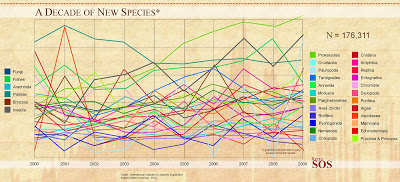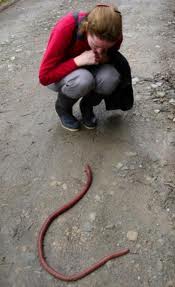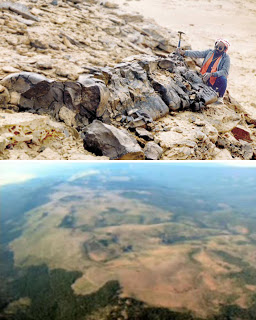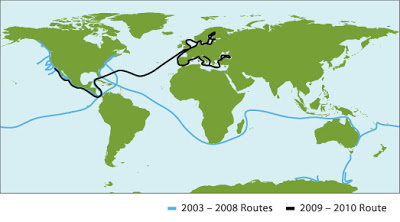Biology
Biology concepts ? biodiversity, kingdoms of life, animalia, plantae, fungi, protist, archaea, bacteria, extant, extinct
At some point in our lives, we have all tried to win the prize by guessing how many jellybeans are in the jar. Number estimation is a skill few people possess, just try ordering mulch by the square yard ? you end up with either half as much as you need or buried in pine bark!
We are counting species, but is it live (extant) species or all species including those that are extinct? The World Wildlife Federation estimates that between 0.01% and 0.1% of all species go extinct each year. However many species we end up with as an estimate for all life on Earth, this is a huge number of species to lose EVERY YEAR. It is scary to think how many undiscovered species will go extinct this year. There must be thousands and thousands of species that we will never get to describe using a live specimen or discover how they might add to the diversity of the planet.
If 170,000 were discovered in ten years, the total number of species on Earth must be huge. Let?s break down the numbers of catalogued species and the estimates by kingdom.
Plantae ? Plants include the non-vascular mosses, the vascular, spore-forming ferns and horsetails, the seed bearing gymnosperms (conifers and such) and the fruiting and flowering angiosperms. So many of these organisms are crucial for human life (medicine, food, oxygen!) we have done a good job of cataloguing them. The 2011 Mora paper surmises that we have already described nearly 50% of the total number of species.
If you compare plant diversity to fungi, fungi win hands down. Described species of fungus lag behind; only 43,000 species have been named, but there is much more room to add new species. Estimates are that by the time we are done, whenever that is, we will have nearly 700,000 different mushrooms and other fungi.
Most bacteria and archaea can?t be grown in the lab because we don?t know what they require to live. This makes them hard to describe and classify. Therefore, the Venter Institute uses DNA techniques from dried whole organisms to identify new ?species.?
- Is There A Limit To Evolution On Earth?
What are our limits to evolution? There are two theories concerning the growth of diversity amongst the planet. These 2 theories include diversity in an equilibrium or diversity that is rapidly expanding (occupying every possible niche, as well as, exploiting...
- Evidence For Evolution
What is the Evidence for Evolution? There are many different pieces of evidence for evolution; paleontology, biogeography, developmental biology, morphology, and genetics. I will be discussing what each piece of evidence means. Paleontology is...
- Bacterial Gene Numbers Range Over An Order Of Magnitude
KEY CONCEPTS:Genome sequences show that there are 500-1200 genes in parasitic bacteria, 1500-7500 genes in free-living bacteria, and 1500-2700 genes in archaea. Large-scale efforts have now led to the sequencing of many genomes. A range is summarized...
- What Is The Status Of Red Panda According To The Iucn Red List?
A) Endangered Species B) Extinct Species C) Vulnerable Species D) Critically Endangered Species The correct answer is: A) Endangered Species...
- Biodiversity And Conservation
Biodiversity is the diversity of biological organisation ranging from cellular macromolecules to biomes. Edward Wilson popularized the term ?biodiversity?. LEVELS OF BIODIVERSITY 1. Genetic diversity: Diversity shown by a single species at genetic level....
Biology
Biodiversity Counts!
Biology concepts ? biodiversity, kingdoms of life, animalia, plantae, fungi, protist, archaea, bacteria, extant, extinct
 |
It seems that contests counting things in jars always involve food. M&Ms, jellybeans, candies, and gumballs are common things to estimate. I like another estimate game ? how many grains of sand can be held in one human hand? Amazingly, only about 10,000. |
There is a large group of scientists playing the jellybean game for a living, but their jar is the entire earth. The jellybeans are species of organisms. The prize? Well, you don?t get to keep the jellybeans; and just how will we know who wins?
The Question of the Day ? How many species of life are there on Earth?
It seems like a straight forward question, but let?s look at it in a bit more detail before we try to answer it. What is it we're counting, animals? Animals and plants? Let?s include everything ? everything that is considered alive. So what is considered alive? You can have a great discussion as to what should be considered alive, but for these purposes, let?s stick to the kingdoms of life as taught in every biology class ? Archaea, Bacteria, Protists, Fungi, Plants, and Animals.
So now that we know the biodiversitywe are assessing, we need to define our unit. We said above that we would count species, but it isn?t that simple. We have discussed before what constitutes a species in general ? those animals that can breed and produce fertile offspring. So we don?t count ligers and tigons (crosses between tigers and lions), but should we count all the hybridizations of orchids? More than 24,000 species are named already, with about 800 added each year. For our purposes, and for most people estimating species, we will stick with those found in nature, unaided by man.
 |
In 2012, Japanese botanists crossed two orchids and created a new orchid. No big deal right, orchids are crossed all the time. But this was the first time that a photosynthesizing orchid was crossed with a purely parasitic orchid that doesn?t perform photosynthesis. They think the plants are doing some photosynthesis ? they?re pretty anyway. Is this a species we should count in our estimate? |
Scientists refer to ?catalogued? species, but does that refer to those alive at the time the were described, or any species that has ever been described and named? Scientists estimate that extant species account for only 3% of everything that has lived on Earth, so including all species would greatly increased the overall number. However, in most estimates of species on Earth, the species being talked about are alive now, except for the one went extinct just this second, and the one that will go extinct two minutes from now, and the one?.
The opposite action is also occurring; we discover new species every year. Most people think that perhaps a few new species are found each year, but it?s really in the thousands. The International Institute for Species Exploration (IISE) at Arizona State University publishes a list each year of the newly discovered species. For 2011 the list was more than 18,000 species long! You can see from the picture (below, right) that many discoveries were made in every kingdom of life in the decade of the 2000?s, more than 170,000 discoveries in all.
 |
This graph shows the relative number of new species in many groups of organisms. The scales are variable for each group and can?t be compared amongst the groups. The trends show that in some groups, more and more species are being discovered each year, while in others, fewer and fewer are being found. In still others, some years a bunch are found and some years provide few or no new species. |
Animalia ? These are what most people think of when asked to name a species. Most animals are relatively big and can be seen in everyday life. The number of catalogued species includes the dinosaurs and humans, birds and sponges. The numbers in each group vary greatly.
People love to study birds ? so we have probably found a greater percentage of the total number of birds than we have worms. We have named about 10,000 species of birds, and more than 22,000 species of annelids (segmented worms). But there are probably many more annelids that we have not found as compared to birds. Therefore the estimate for annelids will be harder to make and perhaps less accurate.
For all animals, the total number of catalogued species by 2010 was 1.2 million. A recent paper (2011, Mora et al.) has predicted the number of species in most kingdoms based on several mathematical models. The authors predict that there are more than 9.9 million animal species on the Earth and in the oceans. According to this estimate, we have found only 12% of all the animals on Earth!
 |
Meet the Giant Gippsland Earthworm (Megascolides australis). It can reach 3meters (10 feet) in length. First described in 1878, this worm lives in the deep clay soil in a small area in Australia. Similar worms live in North America, but they are rarely observed. |
Their methodology uses a lot of math to relate the number of higher taxa (phylums, orders, families) that are known in well-described kingdoms to the possible number in lesser studied groups. They found that there was a consistent pattern in which the more families there are now can be used to predict how many total genera there might be, and each level then can be used to predict the number in kingdoms for which the number of higher taxa are known. They also use methods to predict unknown higher taxa, so they can be included in the species estimate.
For plants, the Mora group predicts that there are 314,000 species extant on Earth. Other estimates also come out at about 300,000 species, but they include algae, which are actually protists, not plants.
Fungi ? These organisms range from the invisible to the visible. In fact, in the paleoworld, fungi represented the largest organisms on Earth. Even today, the largest single organism is a fungus in the Malheur National Forest in Oregon, where a single 8,000 year old honey mushroom covers 2,200 acres (8,900 square meters) of land.
 |
On the top is a fossilized prototaxite fungus in Saudi Arabia that once reached 20 ft (6 m) in height and was the tallest organism on the early Earth (this one is on its side). On the bottom is the national forest where a single honey mushroom mat has killed 2200 acres of trees. Each mushroom is a clone, connected by a rhizoid mat just under the ground. |
Protista ? Protists are a bit of a catch-all kingdom. Some have aspects that make them look like plants; they perform photosynthesis or they have central vacuoles. Others are much more animal-like. Overall, they are free-living organisms that are usually single celled or made up of many cells not forming tissues. Two examples show you the diversity in this group. Giant sea kelp (Macrocystis pyrifera) is a type of brown algae that can grow at a rate of 2 ft/day and can reach a length of 300 ft (91.5 m), while picoplankton are 0.2 microns (0.00000002 m) in diameter, are single celled, and may or may not perform photosynthesis.
The estimates for the number of protists vary greatly. A 1998 study indicated that they had no reason to believe the total number of protist species would be greater than 3000. However, a 2005 report puts the estimate number anywhere from 140,000 to 1.6 million. The Mora group?s paper estimates that about 73,000 will be found; that?s 57,000 more than have been described as of 2010.
Archaea and Bacteria? These are the prokaryotes. They live in tar pits and arm pits; they own the planet and probably outer space as well. There are more bacteria in a scoop full of dirt then people who have ever lived on Earth. But for the purposes of our discussion today, the important part is that same scoop of dirt has thousands of undiscovered bacteria.
The J. Craig Venter Institute is leading the Global Ocean Sampling Expeditions to discover new marine microorganisms. A pilot expedition in 2003 identifed 1800 new species in just a couple of months. This was followed by global expeditions in 2005-2009 and an expedition to the European waterways in 2009-2010. They will analyzing the data and naming species for decades to come.
 |
This map represents the expeditions of the Global Ocean Sampling Projects of the Venter Institute. As they traveled, they would acquire 200-400 gallon samples of water from different depths every 200 miles and put them through a series of filters to catch smaller and smaller organisms. The filters would be dried and used for DNA analysis. In just a couple of months, 1.2 million genes were identified using this methodology. |
But perhaps classification is not the proper term for these organisms. I talked to Dr. Mora about why prokaryotes were not analyzed to the same degree as other kingdoms in their paper. He rightfully pointed out that species definitions don?t really apply to prokaryotes as neatly as they do other types of organisms.
Certainly they don?t conform to the mating and fertile offspring definition of species since they don?t mate. Also, since they swap DNA as usual business (lateral gene transfer), who is to say where one species stops and another begins.
Other sources are little more daring in projecting possible numbers of prokaryotes. It is possible that there are a billion distinct bacteria and archaea, but it more likely that the number is in the 10-20 million range.
What are our final numbers when add up all the estimates? Predicted species numbers for life on Earth range from 11.3 million in the Mora paper, to perhaps more than 1 billion if you include prokaryotes. If we leave the bacteria out of the equation, there could still be as many as 30,000,000 forms of life on the planet. We have described about 2 million (according to IISE), so only 28,000,000 left to find!
Mora, C., Tittensor, D., Adl, S., Simpson, A., & Worm, B. (2011). How Many Species Are There on Earth and in the Ocean? PLoS Biology, 9 (8) DOI: 10.1371/journal.pbio.1001127
ADL, S., SIMPSON, A., FARMER, M., ANDERSEN, R., ANDERSON, O., BARTA, J., BOWSER, S., BRUGEROLLE, G., FENSOME, R., FREDERICQ, S., JAMES, T., KARPOV, S., KUGRENS, P., KRUG, J., LANE, C., LEWIS, L., LODGE, J., LYNN, D., MANN, D., MCCOURT, R., MENDOZA, L., MOESTRUP, O., MOZLEY-STANDRIDGE, S., NERAD, T., SHEARER, C., SMIRNOV, A., SPIEGEL, F., & TAYLOR, M. (2005). The New Higher Level Classification of Eukaryotes with Emphasis on the Taxonomy of Protists The Journal of Eukaryotic Microbiology, 52 (5), 399-451 DOI: 10.1111/j.1550-7408.2005.00053.x
- Is There A Limit To Evolution On Earth?
What are our limits to evolution? There are two theories concerning the growth of diversity amongst the planet. These 2 theories include diversity in an equilibrium or diversity that is rapidly expanding (occupying every possible niche, as well as, exploiting...
- Evidence For Evolution
What is the Evidence for Evolution? There are many different pieces of evidence for evolution; paleontology, biogeography, developmental biology, morphology, and genetics. I will be discussing what each piece of evidence means. Paleontology is...
- Bacterial Gene Numbers Range Over An Order Of Magnitude
KEY CONCEPTS:Genome sequences show that there are 500-1200 genes in parasitic bacteria, 1500-7500 genes in free-living bacteria, and 1500-2700 genes in archaea. Large-scale efforts have now led to the sequencing of many genomes. A range is summarized...
- What Is The Status Of Red Panda According To The Iucn Red List?
A) Endangered Species B) Extinct Species C) Vulnerable Species D) Critically Endangered Species The correct answer is: A) Endangered Species...
- Biodiversity And Conservation
Biodiversity is the diversity of biological organisation ranging from cellular macromolecules to biomes. Edward Wilson popularized the term ?biodiversity?. LEVELS OF BIODIVERSITY 1. Genetic diversity: Diversity shown by a single species at genetic level....
